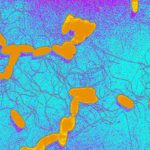Link to Pubmed [PMID] – 17650961
Microb. Drug Resist. 2007;13(2):102-7
We studied the prevalence of resistance to extended-spectrum cephalosporins (ESC) among 1,078 Salmonella enterica isolates collected from adults admitted to Botkin Hospital, St. Petersburg, Russia, for gastroenteritis between 2002 and 2005. Only two ESC-resistant isolates were detected, giving a low percentage of strains resistant to ESC (0.2%). One multidrug-resistant (MDR) isolate of the Virchow serotype produced a CTXM-3 extended-spectrum beta-lactamase (ESBL). The bla(CTX-M-3) gene was located downstream from an ISEcp1 element, on an 80-kb conjugative plasmid. The Virchow isolate possessed a class 1 integron with a 2.2-kb gene cassette (dhfrXII-orfF-aadA2). The second ESC-resistant isolate belonged to serotype Newport, was also MDR and produced a CMY-2 cephamycinase. This CMY-2-producing isolate (also called Newport MDR-AmpC) possessed a class 1 integron with a 1-kb gene cassette including a new variant of the aadA gene, aadA24. A large plasmid (>125 kb) was involved in transfer of the bla(CMY-2) gene. The ESC-resistant S. enterica isolates detected in this study were different from those (S. enterica serotype Typhimurium DT193 producing CTXM-4 or CTX-M-5 ESBLs) involved in several nosocomial outbreaks between 1994 and 2003 in Russia. This is the first description of both CTX-M-3 ESBL-producing S. enterica and Newport MDR-AmpC in Russia.
